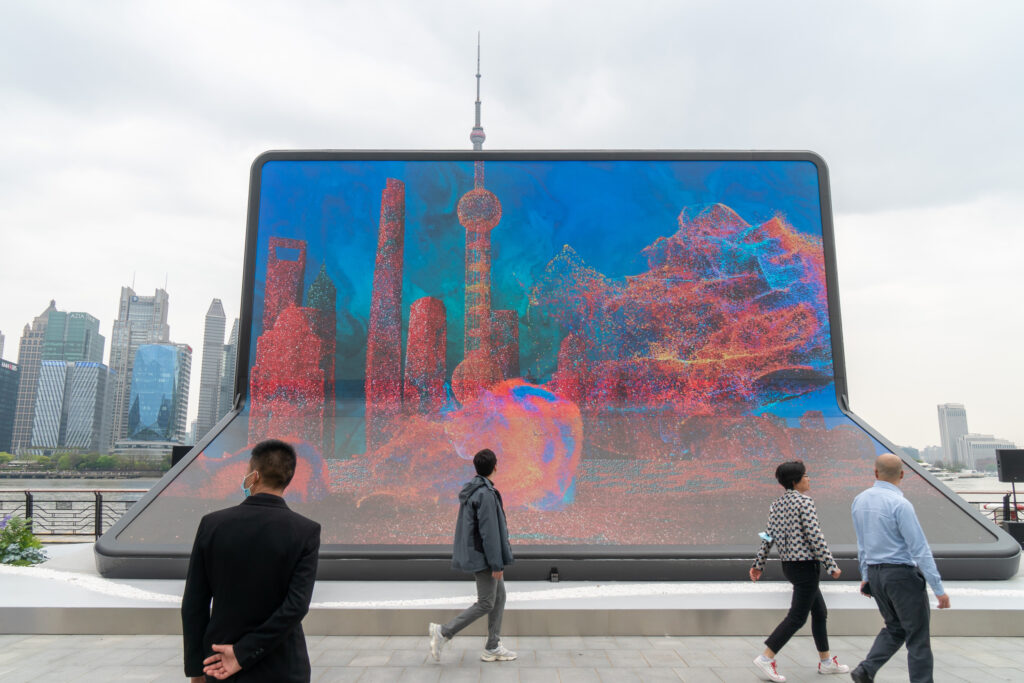Another Reckoning
(With China)

Last summer, a few American writer friends and I traveled across China on a self-organized tour of AI labs, factories, and industrial clusters. Among them was Aadil, a twenty-two-year-old Bay Area engineer who loves the Cantonese rapper SKAI ISYOURGOD and deploys Chinese memes with the fluency of someone raised on the Chinese internet, despite never having lived there.
After the trip, he wrote some reflections on his Substack:
Shenzhen is such a dope city. Legit looks like the future more than any city I’ve been to… Huaqiangbei is massive. Honestly I’m thinking about doing a month-long hardware residency there so I can crash course EE by building stuff hands on.
It is crazy how much their society grinds. It’s in their DNA. The work ethic is insane. Shenzhen was dirt and mud forty years ago and now it’s the world’s example of a cyberpunk city.
Reading his words, I felt a familiar pressure—a small internal shift I had sensed accumulating for years. I left China at 17, in 2012, arrived in the U.S., and absorbed the ambient narratives of American centrality that still held cultural authority then. I spent much of my twenties trying to construct a language that neither flattered nor demonized either country.
But seeing China through Aadil’s eyes forced me to recalibrate. I remember that afternoon by West Lake in Hangzhou, when we did not schedule any tech company visits in order to simply drink tea by the ancient water. I had been to West Lake a few times growing up, but watching Aadil record his vlog with excitement made the lake—with the weight of all its accumulated history—feel at once familiar and alien. His China did not arrive through the frameworks I inherited from college professors, journalists, or scholars. It came through other channels: viral videos of synchronized drone shows, TikTok montages of Shenzhen’s skyline, tech bloggers’ analysis of DeepSeek’s efficiency, Cantonese rap circulating through global youth culture, hardware tutorials filmed in Hangzhou studios by Chinese tech influencers. For Aadil, China is more than a geopolitical puzzle. China is modernity itself. It is what the future is supposed to look like. It is, to borrow Kevin Kelly’s phrase, “Cool China”: a China that produces things other people want to imitate, a place people aspire to visit and live in.
I am eight years older than Aadil, which makes me just far enough away to feel like a different generation. I grew up in a time when the United States still radiated a kind of unquestioned allure. Apple’s iPhone 4 was an object of worship in my high school. China was rising, but not yet glamorous. If you told my teenage classmates that American kids in 2025 would look to China for inspiration, they would have laughed. But something has changed. The drift is subtle but undeniable.
Kaiser Kuo captured one strand of this change in his recent essay “The Great Reckoning.” A friend of mine in London, connected to a group of China watchers, even held a reading club for this piece. Similar arguments have appeared across the U.S., to name a few: Rush Doshi’s “The Moment China Proved It Was America’s Equal,” Eric Schmidt and Selina Xu’s “China Is Building the Future,” among others.
Kaiser writes from the perspective of someone who arrived in China in the late eighties. He witnessed the brink of liberation in 1989, the subsequent crackdown, and the poverty and disorder that younger generations can barely register. Kaiser’s generation absorbed Western triumphalism almost by osmosis, and now must dismantle the frameworks that once felt self-evident. In the piece, his call is for intellectual honesty: “American elites, stop coping. Stop the reflexive yes-but that rushes to minimize Chinese accomplishments before the evidence has even settled.” His message resonates because it names something true: the discomfort many American elites feel when confronted with a world that no longer fits their inherited mental maps.
Over the past few years, though, I have watched versions of reckoning with China unfold across very different milieus, each shaped by a unique vantage point. For Kaiser’s generation of American intellectuals, the reckoning is slow and psychological. For younger Americans like Aadil, it is almost effortless. In Silicon Valley, it is brisk and utilitarian. And inside China’s own online subcultures, it takes a form so alien to Western discourse that it barely registers as the same phenomenon. We are drifting into parallel, sometimes incompatible, ways of seeing the same country.
For Kaiser’s generation, the reckoning is existential. It requires tearing down the intellectual scaffolding that once organized their understanding of the world. It is painful because the story of American centrality was central to their identity. The polling data he cites confirms the generational break. Younger Americans no longer see China as a rival to be contained. They see it as simply part of the landscape, a sovereign fact of their world. They came of age after the 2008 financial crisis, after Iraq, after the chaos of January 6, and in an era when American infrastructure could not build a functional train line between two major cities. American exceptionalism was never something they lived. It was something they heard older people talk about.
This is Aadil’s America and China. It is its own form of innocence. Sometimes, such innocence flattens China into a shiny image, ignores contradictions, and overlooks costs. On TikTok and Instagram, China appears as a glittering spectacle: drones forming three-dimensional shapes above Chongqing, maglev trains gliding in slow motion, factories stamping out EV components at impossible speed, street fashion from Chengdu night markets. Sinofuturism, once an art-world concept coined by Lawrence Lek, has mutated into a mass aesthetic. It is now the default visual grammar through which millions of Westerners encounter China.
Yet this admiration of China also grows out of America’s own crisis. A few months ago, at an event in London, I heard economist Daron Acemoglu explain that liberal democracies are shrinking in both number and legitimacy. Young people increasingly doubt the democratic model, and sympathy for authoritarian alternatives has moved from the fringes toward the center. Antiliberal ideas are gathering force. In a postindustrial economy reshaped by automation, digital technology, and globalization, America’s sense of loss has made China strangely magnetic. Princeton political scientist Rory Truex put it more starkly: America is experiencing democratic erosion. The current administration is conducting “trial-balloon repression.” The irony is pointed: Truex built his career studying Chinese authoritarianism, and now finds himself analyzing similar autocratic patterns at home.
Another version of such “China reckoning” is happening in Silicon Valley. It looks almost nothing like Kaiser’s careful unlearning or Aadil’s intuitive acceptance. In Silicon Valley, the reckoning has already moved into the stage of reverse engineering.
The tech world operates on compressed timelines and instrumental logic. When you are building products or competing in markets, delusion is expensive. This is why Silicon Valley has had little trouble swallowing a bitter fact: in some domains, China has pulled ahead. The result is a growing obsession. For instance, Noah Smith—widely read among Silicon Valley elites—recently wrote about the “Electric Tech Stack” that undergirds drones, EVs, and power electronics, arguing that China dominates this stack because it has built an industrial system that is faster, denser, and more tightly coordinated than anything in the West. His question is blunt: How should the United States respond?
Venture capitalists have undergone their own version of this shift. Essays published by Marc Andreessen’s venture capital firm a16z under the heading of American Dynamism read like memos from a rival civilization studying an ascendant one. Andreessen’s partners and portfolio companies speak openly about the need for the U.S. to develop companies like the Chinese BYD or CATL. Ford’s CEO recently admitted Chinese EVs were shockingly good—a confession that would have been unthinkable a decade ago.
The Progress Movement that I am part of as a writing fellow invokes China with a strange mix of envy and admiration. At the annual Progress Conference in October, China became a kind of motivational poster. The founder of California Forever argued that his plan to build a new city on farmland between the Bay Area and Sacramento could be America’s answer to Shenzhen. Naval architects and robotics entrepreneurs spoke reverently about Chinese shipbuilding and humanoid robot production lines. Even when they criticize China’s political system, they treat its industrial capacity as the baseline of what is possible.
What Silicon Valley lacks in philosophical depth, it compensates for in practical comprehension. The builders I meet are studying Chinese manufacturing processes, examining how BYD combines battery production, motor design, and vehicle assembly under one roof. They quote Dan Wang’s Breakneck the way earlier generations quoted The Innovator’s Dilemma.
On top of reckoning, Silicon Valley’s China obsession runs in two contradictory directions. In one direction, geopolitical competition provides convenient justification: AI labs invoke the China threat to legitimize spending enormous sums on infrastructure and compute. In this framing, China becomes the rival racing toward AGI—a competitor we dare not underestimate, one that must be contained. “Winning the AI race against China” becomes recast as existential necessity.
But in the other direction critics are increasingly asking whether Silicon Valley has become pathologically fixated on China. Rather than fatal competitor, China is Silicon Valley’s obsessive ideal. However, this narcissistic imagining of China as mirror and nemesis, may reveal less about China itself than about Silicon Valley’s own crisis of legitimacy and direction.

Another reckoning story is unfolding alongside the others, and it is the one that always catches outsiders off guard. While Western commentators are trying to see China more clearly through the tools of Western theory, young Chinese netizens have been busy coining vocabularies to say something different. They are learning to see China by stepping outside the Western perspective altogether. Some of the most imaginative thinking in China today is happening not in universities or policy institutes but in the chaotic, half-serious, half-sardonic corners of the internet. Out of these keyboard politics circles (键政圈) has emerged a whole mini-universe of homegrown concepts: the Industrial Party with its faith in engineers, ruguan theory (入关学) with its historical allegories, and, most recently, the irreverent and strangely revealing world of yingxue, or winnology (赢学).
The lineage of these ideas starts in the early 2000s, when clusters of patriotic young people on forums like Tianya and Tieba pushed back against the liberal vocabulary that dominated Chinese online debates. A few years later, this impulse hardened into something more coherent. The Industrial Party, a loose collective of engineers and technocrats, believed that the real story of modern China lay in factories, logistics chains, and infrastructure, not in moral sermonizing. Their heroes were not dissidents or thinkers but people who could build bridges and power grids.
Out of this soil grew something sharper. In 2019, at the height of the US-China trade war, a new idea swept across Zhihu and Weibo: ruguan, the theory of “entering the pass.” Its imagery came from the seventeenth century, when the Manchu forces broke through Shanhaiguan and replaced the Ming dynasty. Ruguan theorists used that moment as a metaphor for the present. In their telling, the United States looked like a late-Ming empire, still formidable but inwardly fraying, while China resembled the rising but still marginal forces waiting outside the frontier. The ruguan theorists’ message argues that China should stop trying to win approval from people who will never grant it. Build strength. Do the work. And when the power balance shifts, the same Western voices that dismiss China today will rush to explain its rise with great solemnity. A popular line captured this mood with a mix of humor and fatalism: after China enters the pass, the great scholars will write our arguments for us (“入关之后,自有大儒为我辩经”).
Winnology takes this impulse and turns it inside out. Its claim is that the difficulty many Chinese intellectuals have in acknowledging China’s successes is psychological. In this account, shaped by young internet theorists and discussed by researchers such as Yu Liang, a kind of invisible caste system has settled into the global imagination after two centuries of Western dominance. Western nations sit near the top by default, their achievements treated as natural extensions of their civilizational essence. Chinese achievements, by contrast, are received with suspicion: if China moves quickly, it must be cutting corners; if it innovates, it must have copied someone; if it wins, it must be winning wrong.
The metaphor is intentionally outrageous, but that is why it works. It names something people feel even if they cannot articulate it. It explains why some Chinese critics instinctively downplay progress at home, and why some Western commentators struggle to see Chinese accomplishments as legitimate. Winnology exaggerates, but its exaggeration has a purpose. It surfaces the hidden rules that shape how people talk about China, rules that have rarely been stated aloud.
Kaiser writes that Chinese intellectuals still hesitate to absorb what China’s success actually means. I see the same hesitation, but with a twist he only gestures at. The people who struggle most are often those who know the West best. They write and think in Western frameworks, and must constantly translate themselves into a language that will be understood abroad. The result is a kind of double consciousness. To be legible to Western readers, they must speak in Western terms. To be honest to themselves, they must step outside those terms entirely. It is a difficult balancing act, and many fall back into the familiar comfort of Western theories even as they try to question them.
Meanwhile, on the Chinese internet, an entirely different sensibility is taking shape. Young users, unburdened by the need for international approval, play with ideas more freely. They make theories out of memes, stitch together allegories from history and science fiction, and build conceptual worlds that do not seek validation from anyone outside their own circles. Their reckoning is not a continuation of Western thought, nor a rebellion against it. It is a refusal to let Western categories set the terms of their imagination.
There is one more layer I feel compelled to add, a part of China that has never required calibration from me because it has never shifted beneath my feet. It is the China I grew up with, the one that has remained constant beneath all the reckonings I have described. If Kevin Kelly writes of a “Cool China” that Americans are obsessed with, I want to gesture toward something that sits alongside it and often underneath it, something I can only call the “real China.” I do not mean real in any absolute or lofty sense. I mean real in the way Jia Zhangke’s films are real: the high-tech, the robots, and the glittering skylines are background scenery, while the human beings—their routines, their disappointments, their stubborn joys—occupy the center of the frame.
This real China is made up of small town strivers and test-takers (小镇做题家), of the dense, improvised life inside urban villages, of the delivery drivers and gig workers who knit the country’s convenience together. For many of them, the cool China that dazzles Silicon Valley and TikTok barely registers.
A recently published memoir, I Deliver Parcels in Beijing, has been circulating in Western media. Its author, Hu Anyan, is one of the countless gig workers who embody this quieter, heavier, darker China. He writes about racing through Beijing during heat waves and freezing dawns, about sleeping in cramped rooms without air conditioning to save money, about the fragile economy of hopes he has built around each shift. His voice is innocent, almost childlike, yet what he describes is the most unforgiving edge of the system that produces so many of China’s spectacular surfaces.
When I think of Aadil wandering through Shenzhen in awe, I also think of my own mornings in that city. During that trip, my daily ritual was a 6 yuan latte from Luckin Coffee. That summer, China’s coffee chains were locked in a brutal price war, each company trying to out-subsidize the other. The result was absurdly cheap drinks, delivered to your doorstep. My cup arrived each morning. It came on the back of a scooter, carried by someone not unlike Hu Anyan, someone whose labor made the “cool China” visible to visitors while remaining almost invisible oneself.
If Aadil’s Shenzhen is the city seen from above, then there is also the Shenzhen seen from Hu Anyan’s perspective, built out of exhaustion, improvisation, and quiet endurance. Helen Gao’s recent New York Times piece “The China That the World Sees Is Not the One I Live In” shows such disparity. The state, she argues, presents an image of national confidence and industrial power, yet beneath that polished surface she observes something closer to fatigue: joblessness, shrinking household wealth, a pervasive unease about the future. It is a society that feels, in her words, wai qiang, zhong gan (外强中干): outwardly strong, inwardly brittle.
I nodded as I read her piece, reminded that China has always required a certain tolerance for tension, a willingness to hold several truths at once without flattening them. Perhaps the reckoning is nothing grander than that: a small but deliberate adjustment of the lens, letting a more complicated country come into focus, one that is capable of immense promise and real harm at the same time. Not choosing which China is true, but allowing that all of them are.
Afra Wang is a writer, researcher, and podcaster. Her newsletter, Concurrent, focuses on the tech and cultural currents shaping Silicon Valley, China, and beyond.


